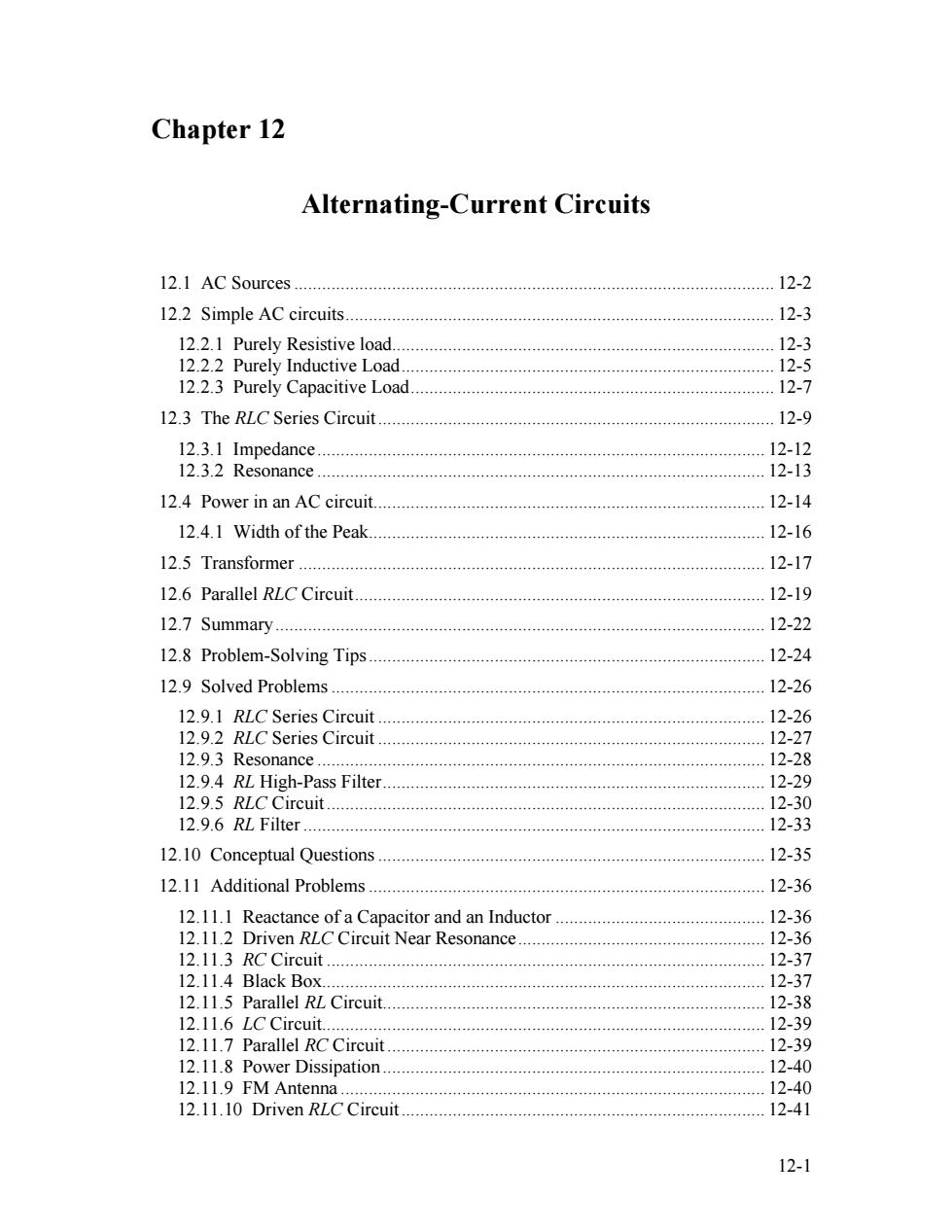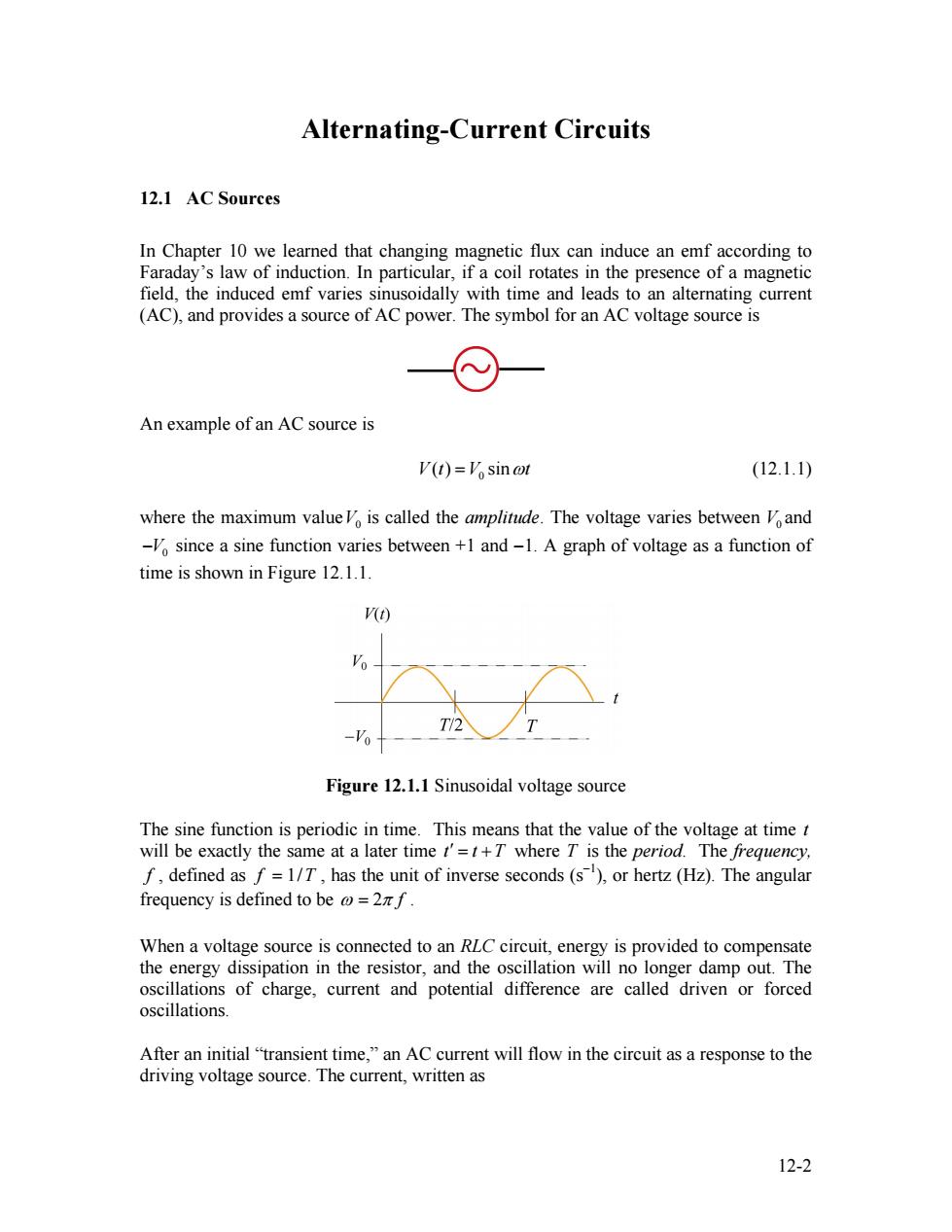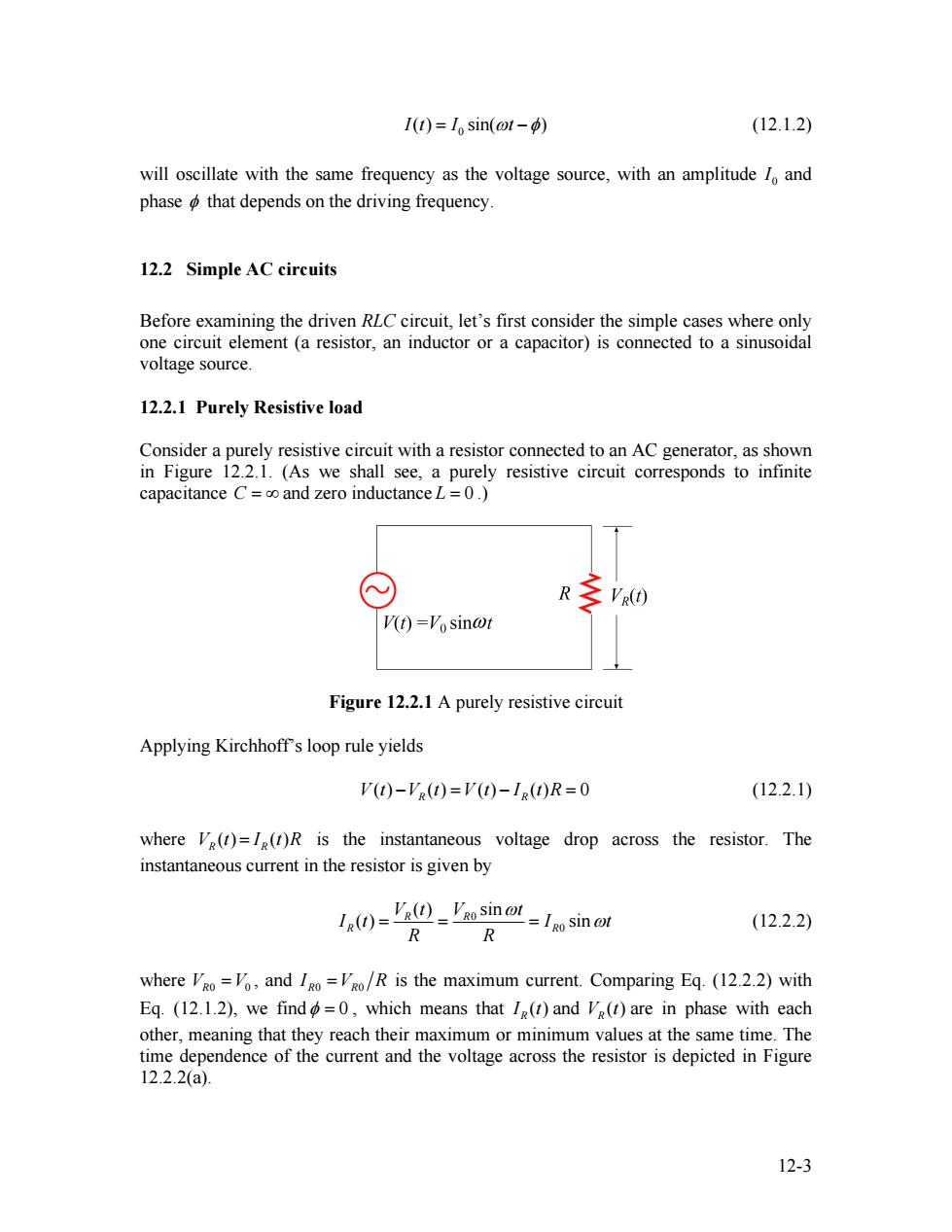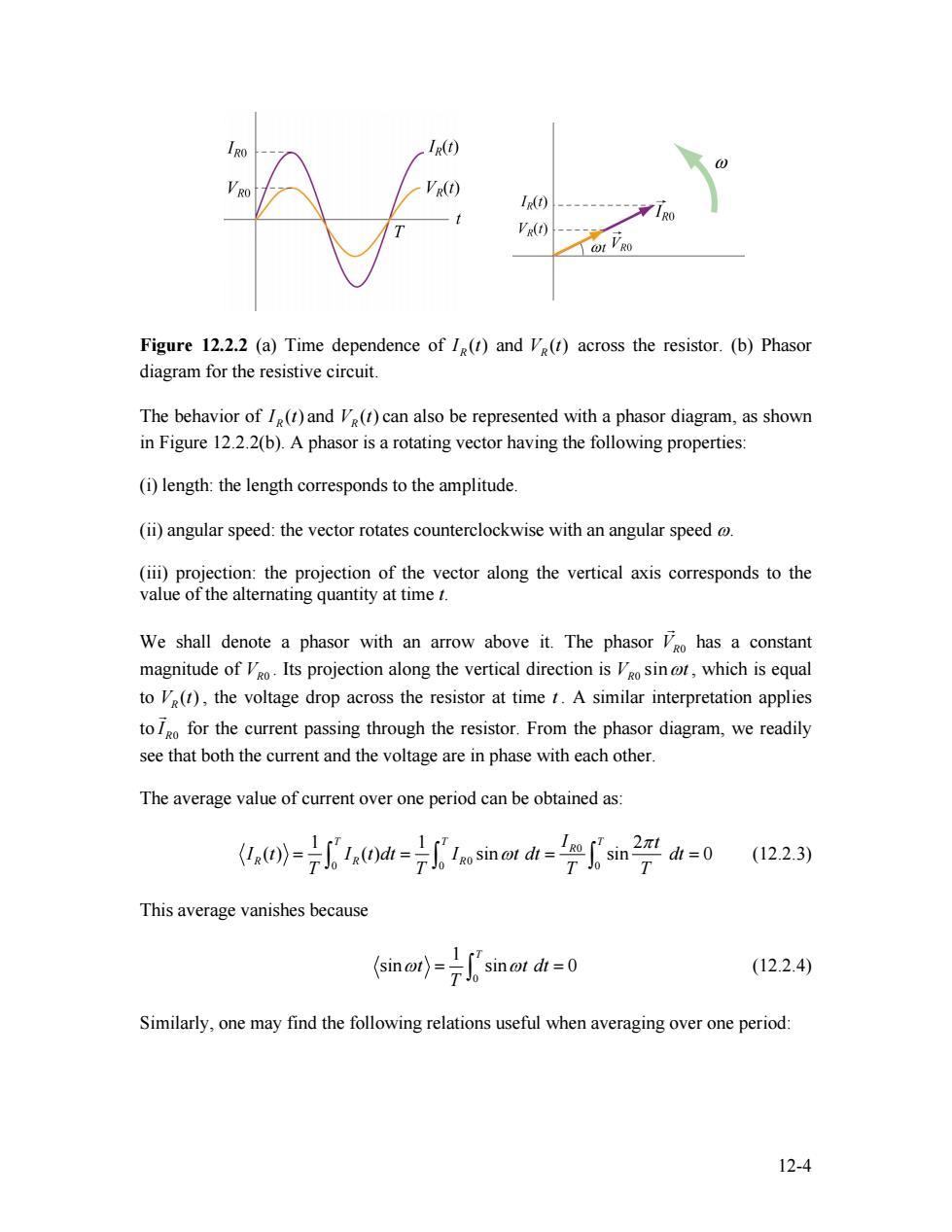
Chapter 12 Alternating-Current Circuits 12.1 AC Sources.… 12-2 12.2 Simple AC circuits............. 12-3 12.2.1 Purely Resistive load.... 12-3 12.2.2 Purely Inductive Load. 12-5 12.2.3 Purely Capacitive Load. 12-7 12.3 The RLC Series Circuit....... 12-9 12.3.1 Impedance...... 12-12 12.3.2 Resonance..... 12-13 12.4 Power in an AC circuit.. 12-14 12.4.1 Width of the Peak 12-16 12.5 Transformer............ 12-17 12.6 Parallel RLC Circuit... 12-19 12.7 Summary......... 12-22 12.8 Problem-Solving Tips 12-24 12.9 Solved Problems.......... 12-26 12.9.1 RLC Series Circuit 12-26 12.9.2 RLC Series Circuit 12-27 12.9.3 Resonance........... 12-28 12.9.4 RL High-Pass Filter 12-29 12.9.5 RLC Circuit............... 12-30 12.9.6 RL Filter....... 12-33 12.10 Conceptual Questions 12-35 12.11 Additional Problems...... 12-36 12.11.1 Reactance of a Capacitor and an Inductor 12-36 12.11.2 Driven RLC Circuit Near Resonance..... 12-36 12.11.3 RC Circuit.… 12-37 12.11.4 Black Box............... 12-37 12.11.5 Parallel RL Circuit........ 。 12-38 12.11.6 LC Circuit........... 12-39 12.11.7 Parallel RC Circuit. 12-39 12.11.8 Power Dissipation...... 12-40 l2.11.9 FM Antenna… 12-40 12.11.10 Driven RLC Circuit. 12-41 12-1
Chapter 12 Alternating-Current Circuits 12.1 AC Sources....................................................................................................... 12-2 12.2 Simple AC circuits............................................................................................ 12-3 12.2.1 Purely Resistive load.................................................................................. 12-3 12.2.2 Purely Inductive Load................................................................................ 12-5 12.2.3 Purely Capacitive Load.............................................................................. 12-7 12.3 The RLC Series Circuit..................................................................................... 12-9 12.3.1 Impedance................................................................................................ 12-12 12.3.2 Resonance ................................................................................................ 12-13 12.4 Power in an AC circuit.................................................................................... 12-14 12.4.1 Width of the Peak..................................................................................... 12-16 12.5 Transformer .................................................................................................... 12-17 12.6 Parallel RLC Circuit........................................................................................ 12-19 12.7 Summary......................................................................................................... 12-22 12.8 Problem-Solving Tips..................................................................................... 12-24 12.9 Solved Problems............................................................................................. 12-26 12.9.1 RLC Series Circuit ................................................................................... 12-26 12.9.2 RLC Series Circuit ................................................................................... 12-27 12.9.3 Resonance ................................................................................................ 12-28 12.9.4 RL High-Pass Filter.................................................................................. 12-29 12.9.5 RLC Circuit.............................................................................................. 12-30 12.9.6 RL Filter................................................................................................... 12-33 12.10 Conceptual Questions................................................................................... 12-35 12.11 Additional Problems..................................................................................... 12-36 12.11.1 Reactance of a Capacitor and an Inductor ............................................. 12-36 12.11.2 Driven RLC Circuit Near Resonance..................................................... 12-36 12.11.3 RC Circuit .............................................................................................. 12-37 12.11.4 Black Box............................................................................................... 12-37 12.11.5 Parallel RL Circuit.................................................................................. 12-38 12.11.6 LC Circuit............................................................................................... 12-39 12.11.7 Parallel RC Circuit ................................................................................. 12-39 12.11.8 Power Dissipation .................................................................................. 12-40 12.11.9 FM Antenna ........................................................................................... 12-40 12.11.10 Driven RLC Circuit.............................................................................. 12-41 12-1

Alternating-Current Circuits 12.1 AC Sources In Chapter 10 we learned that changing magnetic flux can induce an emf according to Faraday's law of induction.In particular,if a coil rotates in the presence of a magnetic field,the induced emf varies sinusoidally with time and leads to an alternating current (AC),and provides a source of AC power.The symbol for an AC voltage source is An example of an AC source is V(t)=Vo sinot (12.1.1) where the maximum valueVo is called the amplitude.The voltage varies between Vo and since a sine function varies between +1 and-1.A graph of voltage as a function of time is shown in Figure 12.1.1. (t) Vo Figure 12.1.1 Sinusoidal voltage source The sine function is periodic in time.This means that the value of the voltage at time t will be exactly the same at a later time t'=t+T where T is the period.The frequency, f,defined as f=1/T,has the unit of inverse seconds(s),or hertz(Hz).The angular frequency is defined to be @=2zf. When a voltage source is connected to an RLC circuit,energy is provided to compensate the energy dissipation in the resistor,and the oscillation will no longer damp out.The oscillations of charge,current and potential difference are called driven or forced oscillations. After an initial "transient time,"an AC current will flow in the circuit as a response to the driving voltage source.The current,written as 12-2
Alternating-Current Circuits 12.1 AC Sources In Chapter 10 we learned that changing magnetic flux can induce an emf according to Faraday’s law of induction. In particular, if a coil rotates in the presence of a magnetic field, the induced emf varies sinusoidally with time and leads to an alternating current (AC), and provides a source of AC power. The symbol for an AC voltage source is An example of an AC source is 0 V t( ) =V sinωt (12.1.1) where the maximum valueV is called the amplitude. The voltage varies between and since a sine function varies between +1 and −1. A graph of voltage as a function of time is shown in Figure 12.1.1. 0 V0 −V0 Figure 12.1.1 Sinusoidal voltage source The sine function is periodic in time. This means that the value of the voltage at time t will be exactly the same at a later time t t ′ = +T where T is the period. The frequency, f , defined as f = 1/T , has the unit of inverse seconds (s−1 ), or hertz (Hz). The angular frequency is defined to be ω = 2π f . When a voltage source is connected to an RLC circuit, energy is provided to compensate the energy dissipation in the resistor, and the oscillation will no longer damp out. The oscillations of charge, current and potential difference are called driven or forced oscillations. After an initial “transient time,” an AC current will flow in the circuit as a response to the driving voltage source. The current, written as 12-2

I(t)=lo sin(ot-φ) (12.1.2) will oscillate with the same frequency as the voltage source,with an amplitude lo and phase o that depends on the driving frequency. 12.2 Simple AC circuits Before examining the driven RLC circuit,let's first consider the simple cases where only one circuit element (a resistor,an inductor or a capacitor)is connected to a sinusoidal voltage source. 12.2.1 Purely Resistive load Consider a purely resistive circuit with a resistor connected to an AC generator,as shown in Figure 12.2.1.(As we shall see,a purely resistive circuit corresponds to infinite capacitance C=co and zero inductance L=0.) R VR(O) (t)='osinωt Figure 12.2.1 A purely resistive circuit Applying Kirchhoffs loop rule yields V(t)-V(t)=V(t)-I()R=0 (12.2.1) where Ve(t)=I(t)R is the instantaneous voltage drop across the resistor.The instantaneous current in the resistor is given by (V(Vaosin ot sin ot R (12.2.2) R where VRo =Vo,and Igo=VRo/R is the maximum current.Comparing Eq.(12.2.2)with Eq.(12.1.2),we find=0,which means that I(t)and V(t)are in phase with each other,meaning that they reach their maximum or minimum values at the same time.The time dependence of the current and the voltage across the resistor is depicted in Figure 12.2.2(a). 12-3
0 I t( ) = I sin(ωt −φ) (12.1.2) will oscillate with the same frequency as the voltage source, with an amplitude 0 I and phase φ that depends on the driving frequency. 12.2 Simple AC circuits Before examining the driven RLC circuit, let’s first consider the simple cases where only one circuit element (a resistor, an inductor or a capacitor) is connected to a sinusoidal voltage source. 12.2.1 Purely Resistive load Consider a purely resistive circuit with a resistor connected to an AC generator, as shown in Figure 12.2.1. (As we shall see, a purely resistive circuit corresponds to infinite capacitance C = ∞ and zero inductance L = 0 .) Figure 12.2.1 A purely resistive circuit Applying Kirchhoff’s loop rule yields ( ) ( ) ( ) ( ) 0 V t VR R − t = − V t I t R = (12.2.1) where is the instantaneous voltage drop across the resistor. The instantaneous current in the resistor is given by ( ) ( ) V t R R = I t R 0 0 ( ) sin ( ) sin R R R V t V t R I t R R I t ω = = = ω (12.2.2) where , and VR0 =V0 R0 R0 I =V R is the maximum current. Comparing Eq. (12.2.2) with Eq. (12.1.2), we findφ = 0 , which means that ( ) RI t and are in phase with each other, meaning that they reach their maximum or minimum values at the same time. The time dependence of the current and the voltage across the resistor is depicted in Figure 12.2.2(a). ( ) VR t 12-3

RO IR(t) V RO VR(t) I(t) ----10 VR(A) Figure 12.2.2 (a)Time dependence of I(t)and Ve(t)across the resistor.(b)Phasor diagram for the resistive circuit. The behavior of I(t)and V(t)can also be represented with a phasor diagram,as shown in Figure 12.2.2(b).A phasor is a rotating vector having the following properties: (i)length:the length corresponds to the amplitude. (ii)angular speed:the vector rotates counterclockwise with an angular speed @ (iii)projection:the projection of the vector along the vertical axis corresponds to the value of the alternating quantity at time t. We shall denote a phasor with an arrow above it.The phasor Vgo has a constant magnitude ofo Its projection along the vertical direction is osin,which is equal to V(t),the voltage drop across the resistor at time t.A similar interpretation applies to for the current passing through the resistor.From the phasor diagram,we readily see that both the current and the voltage are in phase with each other. The average value of current over one period can be obtained as: (()(dsino d sin (12.2.3) This average vanishes because sin ot dt =0 (12.2.4) Similarly,one may find the following relations useful when averaging over one period: 12-4
Figure 12.2.2 (a) Time dependence of ( ) RI t and ( ) VR t across the resistor. (b) Phasor diagram for the resistive circuit. The behavior of ( ) RI t and can also be represented with a phasor diagram, as shown in Figure 12.2.2(b). A phasor is a rotating vector having the following properties: ( ) VR t (i) length: the length corresponds to the amplitude. (ii) angular speed: the vector rotates counterclockwise with an angular speed ω. (iii) projection: the projection of the vector along the vertical axis corresponds to the value of the alternating quantity at time t. We shall denote a phasor with an arrow above it. The phasor has a constant magnitude of . Its projection along the vertical direction is VR0 G VR0 0 sin VR ωt , which is equal to , the voltage drop across the resistor at time t . A similar interpretation applies to ( ) VR t R0 I G for the current passing through the resistor. From the phasor diagram, we readily see that both the current and the voltage are in phase with each other. The average value of current over one period can be obtained as: 0 0 0 0 0 1 1 2 ( ) ( ) sin sin 0 T T T R R R R I t I t I t dt I t dt dt T T T T π = = ω = ∫ ∫ ∫ = (12.2.3) This average vanishes because 0 1 sin sin 0 T t t T ω = ω dt = ∫ (12.2.4) Similarly, one may find the following relations useful when averaging over one period: 12-4

(eosa)=cod=0 sin arcor)sin rcos (12.2.5) 如侧叫号momm(2)-月 (coi m)=oi m=os(2)=月 From the above,we see that the average of the square of the current is non-vanishing: o)=0通=%smah=sm(2)血=22 It is convenient to define the root-mean-square(rms)current as -芳 (12.2.7) In a similar manner,the rms voltage can be defined as -o-芳 (12.2.8) The rms voltage supplied to the domestic wall outlets in the United States is V'ms=120 Vat a frequencyf=60 Hz. The power dissipated in the resistor is PR(t)=Ig(t)VR(t)=IR(t)R (12.2.9) from which the average over one period is obtained as: o-2@R=5aR=R=1-g (12.2.10) R 12.2.2 Purely Inductive Load Consider now a purely inductive circuit with an inductor connected to an AC generator, as shown in Figure 12.2.3. 12-5
0 0 2 2 2 0 0 2 2 2 0 0 1 cos cos 0 1 sin cos sin cos 0 1 1 2 sin sin sin 2 1 1 2 cos cos cos 2 T T T T T T t t dt T t t t t dt T t t t dt dt T T T t t t dt dt T T T ω ω ω ω ω ω π ω ω π ω ω = = = = ⎛ ⎞ = = ⎜ ⎟ ⎝ ⎠ ⎛ ⎞ = = ⎜ ⎟ ⎝ ⎠ ∫ ∫ ∫ ∫ ∫ ∫ 1 1 = = (12.2.5) From the above, we see that the average of the square of the current is non-vanishing: 2 2 2 2 2 2 0 0 0 0 0 1 1 1 2 ( ) ( ) sin sin 2 T T T R R R R t 2 0 1 R I t I t dt I t dt I dt I T T T T π ω ⎛ ⎞ = = = ⎜ ⎟ = ⎝ ⎠ ∫ ∫ ∫ (12.2.6) It is convenient to define the root-mean-square (rms) current as 2 0 rms ( ) 2 R R I I I = t = (12.2.7) In a similar manner, the rms voltage can be defined as 2 0 rms ( ) 2 R R V V V = t = (12.2.8) The rms voltage supplied to the domestic wall outlets in the United States is at a frequency . rms V =120 V f = 60 Hz The power dissipated in the resistor is (12.2.9) 2 ( ) ( ) ( ) ( ) P t R R R R = I t V t = I t R from which the average over one period is obtained as: 2 2 2 2 rms 0 rms rms rms 1 ( ) ( ) 2 R R R V P t I t R I R I R I V R = = = = = (12.2.10) 12.2.2 Purely Inductive Load Consider now a purely inductive circuit with an inductor connected to an AC generator, as shown in Figure 12.2.3. 12-5